History of the British Teddy Boy and Culture

A group of Teddy Boys admire the passing Teddy Girls on Clapham Common 1954.
History of the British Teddy Boy Movement
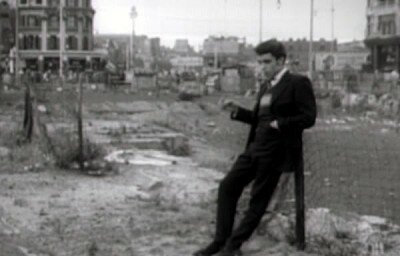
Teddy Boy Mike waits for his friend Pat on a cleared Bombsite, London 1955.
The origins of the Teddy Boys go back to the late 1940's when Saville Row Tailor's attempted to revive the styles of the reign of King Edward VII, 1901-1910, known as the Edwardian era, into men's fashions. The Teddy Boy fashion of the fifties has its origins in what was an upper class reaction to the austerity imposed by the socialist government in the years following the World War II.
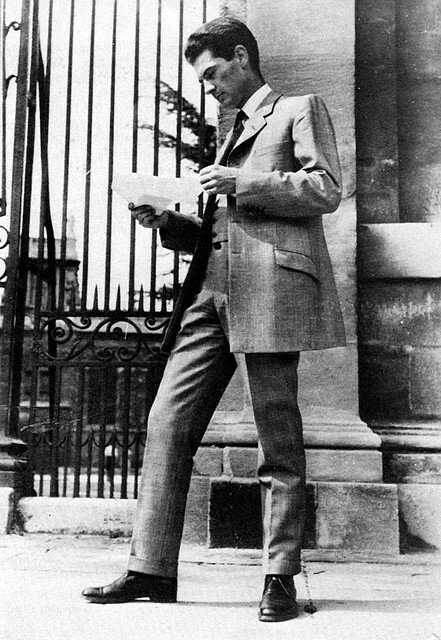
EDWARDIAN STYLE - a photograph from the Tailor and Cutter & Women's Wear, June 23, 1950 with the accompanying text:
"Following on our article concerning the dress of the students up at Oxford, which we printed in our June 9th issue, we show on the right(above) a photograph of Mr. Hugh Street, an Oxford undergraduate who favors the individual in single breasted suits."
"His jacket is generously skirted and button-four with a very short lapel and squarely-cut fronts. Jacket pockets are slanted and are offset by narrow trousers (narrow all the way - not pegged topped) and double breasted waistcoat. The Oxford breeze obliginly blows the left trouser against the Street leg and reveals a fashionable half boot."
Wealthy young men, especially Guards officers adopted, the style of the Edwardian era. At that point in history, the Edwardian era was then just over forty years previous and their grandparents, if not their parents, wore the style the first time around.
Young Oxford undergraduates wearing elements of the neo-Edwardian style in the early 1950's.
The original Edwardian revival was actually far more historically accurate in terms of replicating the original Edwardian era style than the later Teddy Boy style which was a fusion of British Edwardian and American Western styles. Although there had been youth groups with their own dress codes called 'Scuttlers' in 19th century Manchester and Liverpool, Teddy Boys were the first youth group in England to differentiate themselves as teenagers, helping create a youth market.
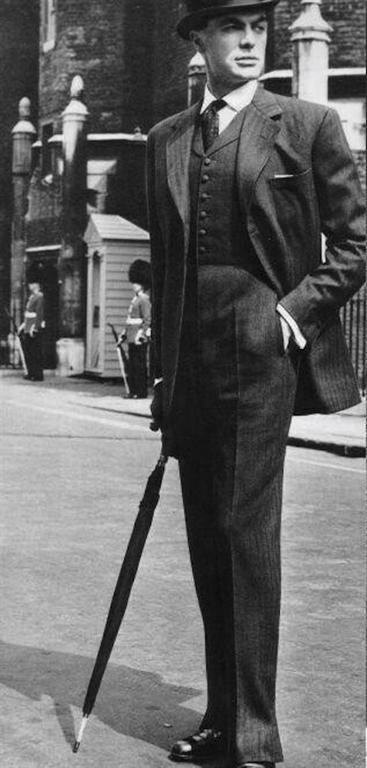
The neo-Edwardian look worn by an off-duty Guards Officer creted by Saville row Tailors in 1948.
"Originally, the Edwardian suit was introduced in 1950 by a group of Saville Row tailors who were attempting to initiate a new style. It was addressed, primarily, to the young aristocratic men about town. Essentially the dress consisted of a long narrow lapelled, waisted jacket, narrow trousers (but without being 'drainpipes'), ordinary toe-capped shoes, and a fancy waistcoat. Shirts were white with cut-away collars and ties were tied with a 'windsor' knot. Headwear, if worn, was a trilby hat. The essential changes from conventional dress were the cut of the jacket and the dandy waistcoat. Additionally, barbers began offering individual styling, and hair-length was generally longer than conventional short back and sides."
The description above was obtained from the typeset of a picture of the 'authentic' Edwardian dress which was put out by the Tailor and Cutter and printed in the Daily Sketch, 14th November 1953, in order to dissociate the 'authentic' from the working class adoption of the style.

TEDDY BOYS - the real thing- who visited "The Post" to demonstrate the authentic version of this youthful London craze.
David Kelly (left) is in "Mississippi gambler style" Tony Griffith (middle) is true to the trend though in no particular style, and Ronald Bunting is in exact replica of Edwardian Fashion.
The principal features are the long coats with fur trimmings (velvet) the drainpipe trousers short of the ankles, the "Slim Jim" ties, fancy waistcoats and gaudy socks. Dressy materials like barathea and gabardine are essential. Between them, they have 10 other similar costumes.
The three youths, all 18 are native Londoners and of the opinion that Wellington's "Teddy Boys" are not really that because they don't dress as well.
Wellington Evening Post (New Zealand) Monday May 30th 7th 1955.
The emergence of the Working Class Edwardian
The 'Edwardian's' or a least 'The Working Class Edwardian' emerged without much warning ....... There was little preparation for his appearance as a fully fledged deviant, ( a person defined as a social problem) .... He had curious parents; one was the upper-class Edwardian dandy, the other the older delinquent subculture of South London .... his clothes were originally worn by the middle and upper classes, but this was only for a short period.

Swindon Teddy Boys at the Hammersmith Palais, London 1955.
....Indeed the style was worn throughout the 1950's, but its meaning changed dramatically over the decade .... When the long jackets and tight trousers covered the middle class, the fashion was proclaimed a pleasing innovation, but it was rapidly re-appraised when it spread to young working-class males in 1952. It seems that these new 'Edwardians' were 'Spivs' not the 'respectable' working class .... as a result, the middle class felt that they could no longer share the style with its new adherents.

Teddy Boys and Girls at The Locarno, Swindon, Wiltshire in 1954
In 1948 Saville Row Tailors got together to push the style on to the young Mayfair bloods, the Guardees, and onto the Businessmen, they pushed it so successfully that it then became the uniform of the dance hall creepers.
"It means" explained a disconsolate young ex-Guardee over a champange coctail, "That absolutely the whole of one's wardrobe immediately becomes unwearable" Those who now wore Edwardian dress were described as delinquents .... Unfavorable social types were summoned forth to define them as, 'zoot-suiters', 'hooligans' and 'spivs' .... The newspaper that these comments appeared in did not hesitate to award them an unambiguous identity .... The clothing was unchanged, but its wearers had translated it into a stigma.

Teddy Boys at High Wycombe, Buckinghamshire in 1957.
Knowing the ingrown conservatism of any English working-class community and its opposition to dandyism and any hint of effeminacy, it must have taken a special boldness for the first Teddy Boys of South London to swagger along their drab streets in their exaggerated outfits.

Teddy Boys Tony Ackrill, Tony Bond and Bill Ferris at Faringdon Road Park, Rodbourne, Swindon, Wiltshire in 1954.
The question which has to be asked is how had this style managed to cross the River Thames? It could hardly have come direct from Savile Row. The general explanation is that it reached South London via Soho. It was a new post-war development that young manual labourers from South London, especially those who had seen military service, went far more readily than before for their evening's entertainment to "the other side", that is, the West end, the square mile of large cinemas and little clubs, jazz haunts and juke box cafe's, which around Soho abut on theatre land and fashionable restaurants.

Teenagers at the Corbett Hospital Fete, Stourbridge, Worcestershire in August 1957 - note the Teddy Boy on the right with the drape with the half-moon pockets.
It was Soho that the Elephant Boys were said to have encountered the new fashion of dressing eccentrically, through meetings either with young Mayfair Edwardians or the latter's Soho imitators. Anyhow, the novel fact was that they picked up the fashion and imitated it, perhaps because its look appealed to them, but probably also because its exaggeration corresponded to something in their own outlook, a nagging dissatisfaction, a compelling demand to draw attention to themselves.

Some young Edwardian's form Wolverhampton around 1955.
A typical 'Spiv' dressed in a long double-breasted suit with a Trilby Hat, the long jacket can be seen to have been heavily influenced by the American Zoot Suit and is regarded as the precursor style to the Edwardian look.

A spiv in 1945 with a Voigtlander camera for sale on the blackmarket in London.
Spivs.
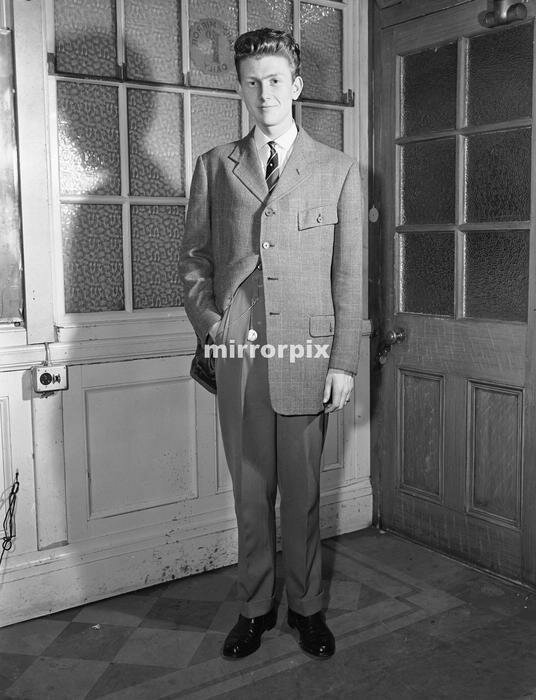
Leonard Sims, a young Teddy Boy sports his newly tailored Drape jacket with flap button-down pockets. The photograph was part of an article published in the daily Mirror Newspaper on Friday 13th November 1955 entitled Why I wear these Togs. 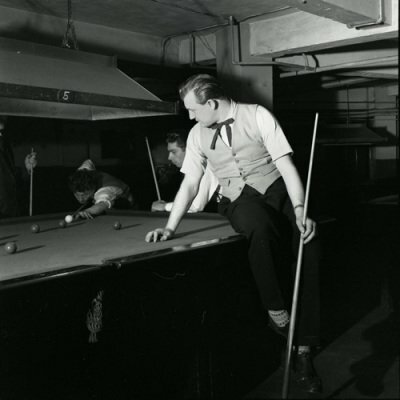
Around 1950/51 these same young men from around Elephant and Castle, Lambeth and the Borough (Southwark) having appropriated the uptown Edwardian clothes started to mix it up with the look of a World War Two Spiv.
 In addition they borrowed the hairstyles and style influences of American Westerns (the Mississippi gambler maverick tie for instance) that were hugely popular in the early fifties.
In addition they borrowed the hairstyles and style influences of American Westerns (the Mississippi gambler maverick tie for instance) that were hugely popular in the early fifties.
The question which has to be asked is how had this style managed to cross the River Thames? It could hardly have come direct from Savile Row. The general explanation is that it reached South London via Soho. It was a new post-war development that young manual labourers from South London, especially those who had seen military service, went far more readily than before for their evening's entertainment to "the other side", that is, the West end, the square mile of large cinemas and little clubs, jazz haunts and juke box cafe's, which around Soho abut on theatre land and fashionable restaurants.


Tony Reuter, one of the Elephant Boys posing as a Teddy Boy for The People Newspaper in 1955.

Outside the ABC, Elephant & Castle, 1954.
TEDDY BOYS - the real thing- who visited "The Post" to demonstrate the authentic version of this youthful London craze.
David Kelly (left) is in "Mississippi gambler style" Tony Griffith (middle) is true to the trend though in no particular style, and Ronald Bunting is in exact replica of Edwardian Fashion.
The principal features are the long coats with fur trimmings (velvet) the drainpipe trousers short of the ankles, the "Slim Jim" ties, fancy waistcoats and gaudy socks. Dressy materials like barathea and gabardine are essential. Between them, they have 10 other similar costumes.
The three youths, all 18 are native Londoners and of the opinion that Wellington's "Teddy Boys" are not really that because they don't dress as well.
Wellington Evening Post (New Zealand) Monday May 30th 7th 1955.
Many young men in the mid-fifties however could not actually afford to purchase the entire Teddy Boy outfit and would wear only elements of it. The shoes were an affordable part of the Teddy Boy style; brothel creepers, lots of entwined leather on the top and thick crepe soles. That element spread as shoes were more readily available than the clothes themselves.
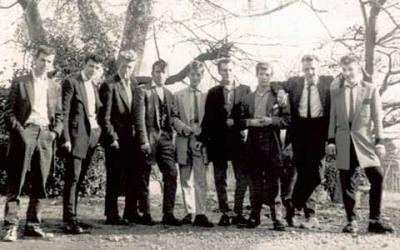
A group of Northampton Teddy Boys all wearing Drape Jackets.
The sartorial signifiers like 'drain-pipe' trousers may well have identified a Teddy Boy however, this would have only been the case within the 'teens and twenties' age bracket. Male teenagers sported certain signs of peer group belonging, like the hair, the trousers and the shoes, but the Teddy Boys uniform in its entirety was not widely adopted by the mainstream teenager. It tended to be those Teddy Boys in gangs who would wear the whole regalia.
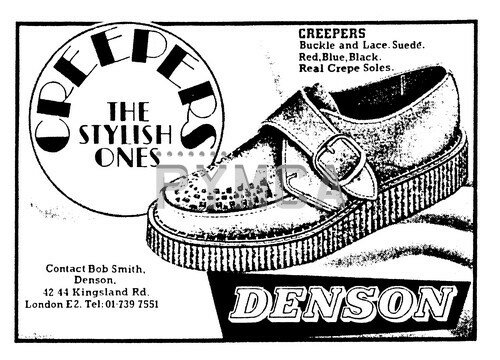
Outside of London, few youths adopted the whole of the Teddy Boy regalia, rather they took on only parts of it - the ones that they could get away with if they could afford them, 'there were a lot of the drainpipe trousers and haircuts and things like that'.

It is estimated that in terms of numbers in 1953-54 there were a 'few thousand' Teds and that they roamed the streets in gangs and that they were territorial and occasionally violent towards other Teddy Boy gangs.
Bob Aber, a then young Teddy Boy from Northampton photographed in London by John Facer in a single link two piece drape suit (the shadow). Note the photograph was made from the negative placed the wrong way round.
Bill Haley and His Comets rehearsing at London's Dominion Theatre, February 6, 1957.
Bill Haley's 'Shake Rattle and Roll' is certainly the record that introduced Rock and Roll to an unprepared British Public. But most people will probably tell you that it was another record that started it all. That other record was 'Rock Around The Clock' which was recorded in 1954, but didn't chart in the UK until October 1955. However, it was still in the chart when 'Rip It Up', Haley's 11th UK success entered the chart at the end of 1956! 'Rip It Up' was almost the last in the amazing run of hit records that Bill Haley had issued in the UK during 1956.
It was the beginning of something new, a wind of freedom. In Britain, in September 1956, Bill Haley had 5 records in the 'Top 20' and the film Rock Around The Clock was shown at 300 cinemas.
At the same time British audiences were also beginning to encounter American rock and roll, initially through films including Blackboard Jungle (1955) and Rock Around the Clock (1955). Both movies contained the Bill Haley & His Comets hit "Rock Around the Clock", which first entered the British charts in early 1955 - four months before it reached the US pop charts - topped the British charts later that year and again in 1956, and helped identify rock and roll with teenage delinquency.
In 1956, the film, Blackboard Jungle made its premier at the Trocadero Cinema at Elephant & Castle in South London. It was then shown thereafter at Cinemas throughout Britain. At the end of the film, the song 'Rock around the Clock' was played and at the Trocodero, Teddy Boys danced with their girls in the aisles and when cinema staff attempted to stop them, they rioted and ripped up the cinema seats with flick knives.
This was replicated at copycat riots during the screening of the film at Cinema's throughout the country. Teddy Boys had now embraced Rock 'n' Roll for the first time and made it their own. The government and media were outraged and the film was subsequently banned from many cinemas. The media jumped on this phenomenon, placing the new rock 'n' roll music and the Teddy Boys at the centre of all the rioting. This confirmed the pre-conception to many members of the establishment, that Teddy Boys were in fact Juvenile Delinquents and social outcasts.
Newspapers were filled with pictures of Teddy Boys and girls dancing and jiving outside the cinemas. The police were frequently involved in quelling, what was in many instances simply teenage high spirits. There can be no doubt that the media had a big hand in sensationalising the rioting and seat slashing, and thereby simply poured fuel on the smouldering embers of the Trocadero riot, and fanned the flames for what in many instances were obviously copycat riots. Blackboard Jungle was also the first major studio film to use Rock 'n' Roll on the soundtrack.
The success of the film, Blackboard Jungle, kick-started sales of Rock Around the Clock by Bill Haley and his Comets, which helped spark the advent of Rock 'n' Roll in Britain.
By the spring of 1957 Bill Haley & the Comets were never to enter the chart again, save re-issues of their previous material. Whatever doubts there may be about Bill Haley's musical influences, he can certainly be credited with unleashing Rock and Roll on the British record buyer.
American rock and roll acts such as Elvis Presley, Little Richard and Buddy Holly thereafter became major forces in the British charts.
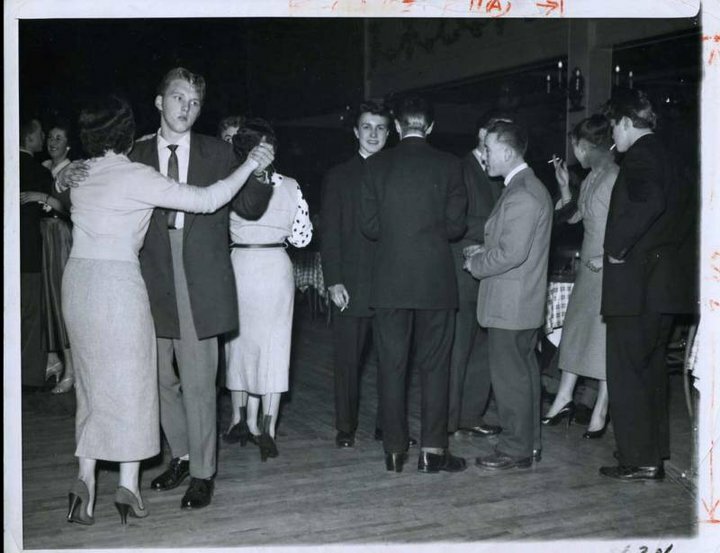
A young Teddy Boy with a Drape jacket and high-waisted trousers dances with his girl at a local Dance Hall.
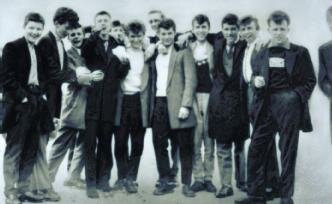
A group of Brierley Hill (Dudley) Worcestershire Teddy Boys mid 1950's
The initial response of the British music industry was to attempt to produce copies of American records, recorded with session musicians and often fronted by teen idols. More grassroots British rock and rollers soon began to appear, including Tommy Steele and Wee Willie Harris. During this period American Rock and Roll remained dominant; however, in 1958 Britain produced its first "authentic" rock and roll song and star, when Cliff Richard & the Drifters (later Shadows) reached number 2 in the charts with "Move It". The 2is Coffee Bar in Old Compton Street, Soho in London's West End became the home of and the birthplace of many of Britain's home-grown Rock 'n' Roll Stars.
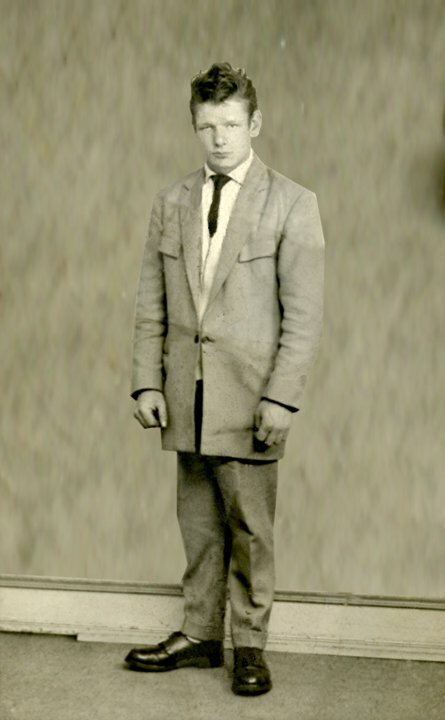
An Edinburgh Teddy Boy in a two piece drape suit that is in need of a good pressing - mid 1950's.
At the same time in 1958, TV shows such as Six-Five Special and Oh Boy! Came about and promoted the careers of British rock and rollers like Marty Wilde and Adam Faith. Cliff Richard and his backing band, The Shadows, were the most successful home grown rock and roll based acts of the era. Other leading acts included Billy Fury, Joe Brown, and Johnny Kidd & The Pirates, whose 1960 hit song "Shakin' All Over" became a rock and roll standard.

Brian Licorice Locking Roy Clark and Vince Eagers first appearance at the 2is Coffee Bar as the Vagabonds circa November 1957.
Teddy Boys are and were a totally British phenomenon as opposed to the other styles worn in countries such as the United States. Also don't forget that Teddy Boys were listening and dancing to mainly Big Band, Jazz and Skiffle type music prior to the advent of Rock 'n' Roll.
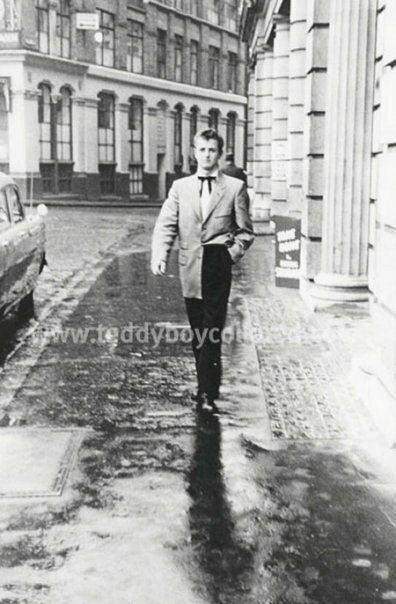
Alec Cruikshank, a clerk in a City of London shipping office walking towards the Mecca Dance Hall, Tottenham, Middlesex (North London) on 29th May 1954.
Criminality and Clothes.
When teenager John Beckley was murdered by a Teddy Boy gang known as the Plough Boys in July 1953 after a fight that started on Clapham Common, the Daily Mirror's headline 'Flick Knives, Dance Music and Edwardian Suits' linked criminality to clothes.
Teddy Boys became regarded by many as the urban, unskilled working class boys, looking for an identity through the clothes they wore. A number of Teddy Boys pursued gang warfare and vandalism in both the streets and the dance halls, carrying coshes, bicycle chains, razors and flick-knives beneath their fine Edwardian style clothes. This reputation then gave any youth who wore elements of the Teddy Boys dress as being tarred with the same brush.
However to many this was a style of dress and a fashion to be worn and of course not all Teddy Boys were as the popular press described. The 1950's was the first decade to produce teenage fashions, before this they were expected to dress similar to their parents. Following the war, when prosperity hit Britain, these working class teenagers could afford to buy their own clothes, although most shops only offered 'off the peg' conventional styles and many tailors refused to make up these 'new' fashions. The teenagers were now a marketing target that made 50's fashion a symbol of a whole new lifestyle.

Teddy Boys were the first real high profile teenagers in Britain, who flaunted their clothes and attitude like a badge. It comes as no surprise then that the media was quick to paint them as violent and a menace based on a single incident. However, many Teddy Boys formed gangs and gained notoriety following violent clashes with rival gangs which were often exaggerated by the popular press.
Many negative newspaper headlines then appeared in the popular press and here are some examples from various cities and towns in England during the mid fifties:
"Cinemas, dance halls and other places of entertainment in South east London are closing their doors to youths in 'Edwardian' suits because of gang hooliganism. The ban, which week by week is becoming more generally applied, is believed by the police to be one of the main reasons for the extension of the area in which fights with knuckle dusters, coshes, and similar weapons between bands of teenagers can now be anticipated. In cinemas, seats have been slashed with razors and had dozens of meat skewers stuck into them."
Daily Mail, 12th April 1954.
Edwardian spivs plan new swoop
GANGS MENACE RESORT
Police are Standing by
BRIGHTON, Saturday Night.
Britain's most famous holiday resort, packed with Easter visitors in it's Centenary year, is being terrorised by rival gangs of "Edwardian" thugs.
Gang fights between rival 'Edwardian thugs' from Southsea, Portsmouth and the East End of London came to a head in one of Britains most popular holiday resorts. In the month of March 1954 the youths, all dressed in the uniform of the of exaggerated Edwardian jackets and drainpipe trousers clashed with a local gang in a quarral over two girls. The visiting gang from Southsea got the worst of it. Two Policemen were called in to quell the disturbance.
The gang announced that they would return with reinforcements on Easter Sunday. Thus Brighton Police, many of them on special duty were standing by to cope with the threatened invasion by the teenage gangsters from the Southsea and Portsmouth area. The Police were determined to do everything possible to avoid a local incident like the Clapham Common youth gang killing, but admit that the 'Edwardians' had the upper hand.
Sunday Chronicle (Brighton), April 18th 1954.

Photo by Ruth Corney
No comments:
Post a Comment